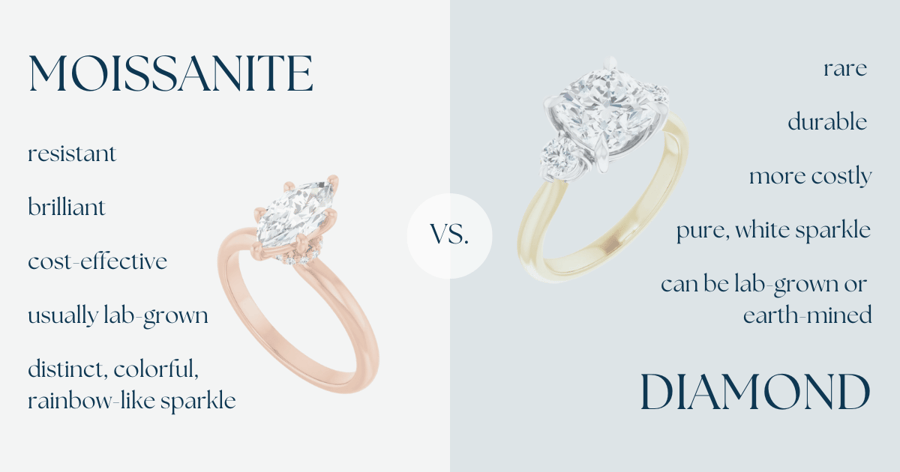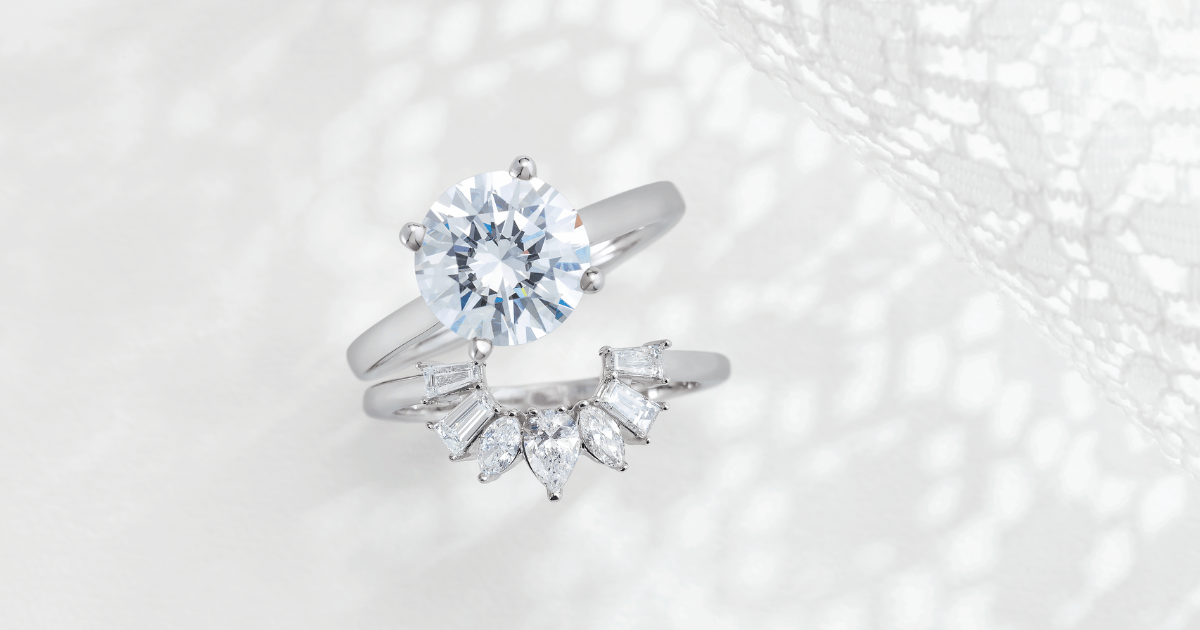Moissanite vs. Diamond: What Are the Differences?
For many years, a diamond engagement ring was the go-to choice for anyone planning to “pop the question” to their partner. But these days, other options have entered the arena, like moissanite rings, which are becoming increasingly popular among couples around the globe.
A big reason behind the success of moissanite engagement rings is how similar they look to diamonds. At first glance, it can even be hard to tell the difference between a moissanite engagement ring and a diamond ring sitting side-by-side.
But you’ll certainly see a difference in the price tag, with moissanite rings famously costing a whole lot less. Along with cost, there are several other factors separating moissanite from diamond, and this moissanite vs. diamond guide will explore them all.
Key Takeaways
- Moissanite offers a cost-effective, brilliant alternative to diamonds, with similar durability but a distinct, colorful sparkle.
- Diamonds hold cultural and historical significance but come with higher costs and potential ethical concerns (when going with earth-mined) compared to lab-grown moissanite.
- Choosing between moissanite and diamond depends on personal preferences regarding price, appearance, and the unique qualities of each gemstone.

What Is a Moissanite?
We’ll kick things off with a look at what the moissanite stone actually is, as there’s a bit of confusion about whether moissanite rings are natural, man-made, or a mix of the two.
Much like diamond, moissanite (or silicon carbide, to give it its scientific name) is a naturally occurring mineral that forms underground. But, unlike diamond, moissanite is very hard to actually mine. This is because natural moissanite gems are so small.
Thus, it’s more or less impossible to make a moissanite ring using natural moissanite stones. Instead, moissanite rings are made with lab-grown moissanite stones. This is part of the reason why they’re relatively cheap, especially compared to diamond jewelry.

Is a Moissanite a Diamond?
No, moissanite is not a diamond. This is a common misconception, and it’s easy to see how it came about, as moissanite and diamond do have much in common. They both form naturally but are also made in laboratories, and both appear similar, at least to the untrained eye.
However, when you really dig into the details of moissanite vs. diamond (as we will below) you start to see how different they truly are. They differ, for example, in terms of their hardness, as well as their “fire” and brilliance in the light.
What Are the Key Differences Between a Moissanite and a Diamond?
Now you know the basics of moissanite, it’s time to dig into the details of moissanite vs. diamond and see how the two compare in several key areas.
Origin
First up, origin. This concerns how and where engagement ring stones are sourced. Or, in other words, whether they’re natural or man-made.
As stated above, a moissanite engagement ring stone will inevitably be lab-grown. This is due to the fact that almost all natural sources of moissanite are just too rare to mine effectively and cut into forms that are suitable for use in rings or other jewelry.
When it comes to diamond rings, it’s a different story. There are both earth-mined (natural) diamonds and lab-grown diamonds to choose from. A natural diamond has a historical significance as a center stone in an engagement ring, but lab-grown diamonds have the benefit of cost-effectiveness.
Composition and Structure
While a lab diamond and a moissanite may appear similar to the naked eye, it’s very different when you observe these gems beneath a microscope.
In terms of their molecular structure, for example, they’re not at all the same. Moissanites are made up of silicon carbide molecules, while diamonds are formed from carbon.
Durability
Diamond is famously the hardest substance on earth. It’s remarkably strong, and the only thing that can effectively scratch a diamond is another diamond. Thanks to this, a single diamond ring can last for generations with no noticeable damage, and the diamond scores a perfect 10 on the Mohs scale of hardness.
Diamond may claim the top spot on that scale, but moissanite isn’t far behind. In fact, it’s the second-hardest gemstone in the world, with a Mohs scale rating of 9.25. It’s not quite as durable as diamond, but it’s very close, and moissanite rings can last just as long as diamond ones.
Brilliance and Fire
Brilliance and fire essentially refer to how sparkly and shiny an engagement ring stone is, and how much it shimmers and glistens in the light. This part of the moissanite vs. diamond breakdown is one that surprises a lot of people, as it’s actually moissanite that comes out on top as the most brilliant.
As such, you can expect a moissanite ring to shimmer and shine even more than a diamond one. Fire-wise (fire refers to the effect of light dispersing into different colors as it bounces and refracts through a gem), moissanite also comes out on top, with around twice as much fire as diamond.
However, there’s a caveat here: moissanite produces a kind of rainbow-like effect in its shine, with lots of different colorsl. Diamond, meanwhile, reflects pure white light more often than not, almost like a disco ball.
Color
In terms of color, the most popular moissanites and diamonds both tend to be colorless or near-colorless. However, other options are available. Moissanites come in shades of teal, green, and yellow, for example, while diamonds may appear pink, blue, and yellow.
Appearance
In terms of appearance, as touched on earlier, moissanite and diamond may look very similar at a glance. However, the longer you look at them, the more differences you may notice, like the “rainbow” shimmer of the moissanite, explained in the previous section.
Clarity-wise, too, there’s a difference. Moissanite stones are almost always completely free of flaws or inclusions, which can make them easier to buy. Diamonds, meanwhile, may have varying levels of quality, with some having little inclusions that impact their aesthetic.
Environmental and Ethical Considerations
Another key difference between a moissanite and a diamond is the ethical considerations, when applicable.
Moissanites are exclusively grown in labs, whereas diamonds can either be earth-mined or lab-grown. While lab-grown diamonds are becoming more popular, there are still plenty of people who choose a diamond that was mined.
However, a significant benefit of lab-grown diamonds (and moissanites) include the positive environmental and ethical considerations. Specifically, lab-grown versus traditionally mined offers “less land scarring, less damage to communities, and fewer airborne toxins.” Moreover, you—as the shopper—can enjoy transparency, because it’s a lot easier to trust the scientific process of creating a diamond in a lab.
Needless to say, it’s recommended you consider what’s important to you when choosing moissanite vs. diamond (and potentially lab-grown vs. earth-mined diamond). We’re always happy to talk to you more one-on-one about the process and/or direct you to additional resources.
Which is Right for You: Moissanite or Diamond?
So, you’ve seen the pros, cons, and key features of moissanite vs. diamond. Now, it’s time to decide which is best.
Well, there’s no single answer to that question. Moissanite isn’t 100% better than diamond, nor is diamond always better than moissanite. As this guide has shown, they both have advantages and drawbacks.
Diamond has cultural and historical value. The diamond ring is a veritable institution. It’s something that many people expect when they receive a proposal, and it’s still the classic, go-to choice for most couples. However, it’s expensive and harder to buy, and there are certain ethical questions around the acquisition of some diamonds.
Moissanite, meanwhile, brings the same level of beauty (or arguably even more beauty) than diamond, at a cheaper price. It’s almost like the best of both worlds, the ideal alternative to a diamond for those who don’t want to spend a fortune and prefer to save up some money for other priorities or wedding celebrations.
So, to decide which one is right for you, you’ll have to weigh up those advantages (and price tags) and make a personal choice.

Moissanite or Diamond Ring Shopping Tips
Let’s finish up with a few helpful tips when shopping for diamond and moissanite rings:
- If you want a diamond ring, look at how and where the diamond was sourced to avoid investing in an unethical product.
- Consider a lab-grown diamond over a natural one to save money.
- Avoid moissanites that are excessively large, as the rainbow reflective effect will be much more visible.
- Reach out to professionals for consultations and guidance on the right ring for you.
Contact Faithful Platform to Make Your Ring Purchase Easier and More Affordable Than Big-Box Retailers
Perhaps you’ve been drawn to the idea of a moissanite ring because of its more affordable nature and shimmering qualities. Or maybe you still wish you could get a natural diamond ring, with all of its pure white reflections and cultural value, without having to spend a fortune.
Either way, we’re here to help. We aim to make engagement rings more affordable and accessible to all, eliminating overhead costs and passing the savings on to you, our customers.
So, no matter which side of the moissanite vs. diamond debate you fall on, you can get the ring of your dreams at the fairest possible price when you buy from us. Contact us today to find out more or get your custom ring design process started.
Not the One Proposing? Drop a Hint.
If you've explored the differences between moissanite and diamond and have a preference, why not share it with your partner? Our Drop a Hint form allows you to subtly communicate your choice, and we'll handle the rest by reaching out to them—no pressure, just a gentle nudge in the right direction.

Frequently Asked Questions (FAQs)
Is moissanite as good as a diamond?
Moissanite offers many of the same qualities as a diamond, including exceptional brilliance and durability, at a fraction of the cost. While it may not carry the same cultural prestige as a diamond, it’s a stunning and budget-friendly alternative.
What is the downside of moissanite?
The main downside of moissanite is its tendency to reflect light in a rainbow-like pattern, which can appear less subtle than a diamond's pure white sparkle. Additionally, moissanite lacks the same cultural and historical significance as a diamond.
Are moissanite diamonds fake?
Moissanite is not a fake diamond; it's a completely different gemstone with its own unique properties. Although it can look similar to a diamond, it is composed of silicon carbide, not carbon, like diamonds.
Can a jeweler tell the difference between a real diamond and moissanite?
Yes, a trained jeweler can usually distinguish between a diamond and moissanite, especially when using specialized tools. While they may look similar to the naked eye, the differences in their molecular structure and light reflection are detectable.
Can someone tell that my ring is moissanite?
To the untrained eye, moissanite can easily be mistaken for a diamond due to its similar appearance. However, under certain lighting conditions, the more colorful sparkle of moissanite might give it away to someone familiar with gemstones.
How much is a 1-carat diamond vs. 1-carat moissanite?
A 1-carat diamond can range from a few thousand dollars to tens of thousands of dollars—depending on factors like color, clarity, cut, and lab-grown vs. earth-mined. A 1-carat moissanite typically costs around $500 to $1,500 for the stone, which is obviously a fraction of the price of a diamond.
The huge difference in price between a diamond and moissanite is because diamonds are rare natural stones whereas a moissanite is a lab-created gemstone. This scarcity drives up the price of diamonds.
